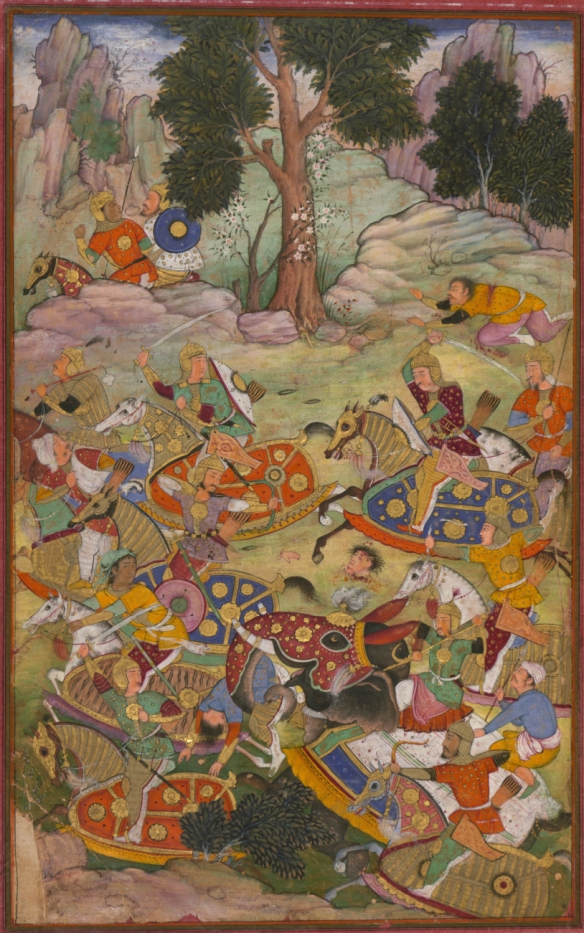The battle of Panipat and the death of Sultan Ibrāhīm.
The Battle of Panipat near Delhi, India, established the Moghul dynasty. Moghul leader Zahir-ud-Din Muhammad Babur, better known as Babur, ruled in Kabul (in present-day Afghanistan) and sought to expand his territory. His father was Turkish and his mother a Mongol, and Babur claimed to be a direct descendent of Timur the Lame, known in the West as Tamurlane. Babur’s goal was to reestablish the Indian empire of his ancestor. Babur’s people were Muslims, known as Moghuls from the Arabic word for “Mongol.”
In 1519 Babur raided into Punjab in northern India. This foray increased his desire to conquer Hindustan, then ruled by Sultan Ibrahim in Delhi. Babur was aided by the fact that Ibrahim’s relatives disputed his right to rule, and several went to Kabul to request assistance from Babur in overthrowing him. A series of complicated alliances resulted, and in November 1525 Babur invaded the Punjab with perhaps 15,000 men.
That spring Babur marched through the Himalayan foothills until he reached the town of Panipat, about 100 miles north of Delhi. Learning that Sultan Ibrahim was moving against him with a much larger force, Babur established a defensive line anchored on the town of Panipat on its right and a gully on the left. Babur had his men scour the countryside for wagons. He then had them rope some 700 wagons together in a line, leaving gaps through which he could move his cavalry and infantry. Some gaps were covered by artillery, which was concentrated in the center with the guns chained together. Babur positioned musketeers armed with matchlocks and cavalry formations on each flank, and he had a small cavalry reserve behind the center of his line. Babur’s possession of gunpowder weapons, which his opponents lacked, turned out to be a significant advantage.
Sultan Ibrahim was in no hurry. On April 12 he arrived from Delhi at the head of
30,000 to 40,000 men and with a number of elephants. He deployed his forces but made no move to attack. Knowing that he was heavily outnumbered, Babur hoped to fight a defensive battle, but the sultan refused to oblige him. Babur’s troops were restive, and delay clearly favored his opponent. Arrow attacks and a few cavalry skirmishes did not elicit the desired response, so to provoke an assault, on April 19 Babur staged a cavalry raid by perhaps 5,000 men against Ibrahim’s camp. The attackers withdrew the next morning in seeming confusion. This ruse had the desired effect. Ibrahim was lulled by the poor showing of the Moghul cavalry into ordering an attack on the morning of April 21.
Ibrahim’s forces moved in echelon across the Moghul front to turn the Moghul right flank. This compressed the Hindustani forces in the vicinity of Panipat as they reorganized prior to launching an assault. Babur ordered his artillery, musketeers, and archers to open fire, which had a devastating effect on the packed Hindustani formation. Babur then launched cavalry forays from his flanks that circled behind the Hindustanis and attacked. Finally, Babur sent infantry and cavalry through gaps in his own line. In the ensuing melee, some 15,000-20,000 Hindustani troops were killed. The remainder managed to break free.
Babur sent his cavalry to pursue the fleeing remnants of the Hindustani force. He also dispatched his son, Humauyun, at the head of a cavalry formation to seize Ibrahim’s treasury at Agra. Babur marched to Delhi, and at the end of April he established himself there as sultan and head of the new Moghul dynasty. The Moghuls ruled India until the British took control of the subcontinent in the 18th century.
References
Babur. The Babur-nama in English: Memoirs of Babur. Translated by Annette Susannah Beveridge. London: Luxac, 1921.
Foltz, Richard C. Mughal India and Central Asia. Karachi: Oxford University Press, 1998. Gascoigne, Bamber. The Great Moghuls. New York: Harper and Row, 1971.
Habib, Irfan, ed. Akbar and His India. Oxford: Oxford University Press, 1997. Lane-Poole, Stanley. Medieval India under Mohammedan Rule. 1903 reprint, New York: Krause, 1970.
